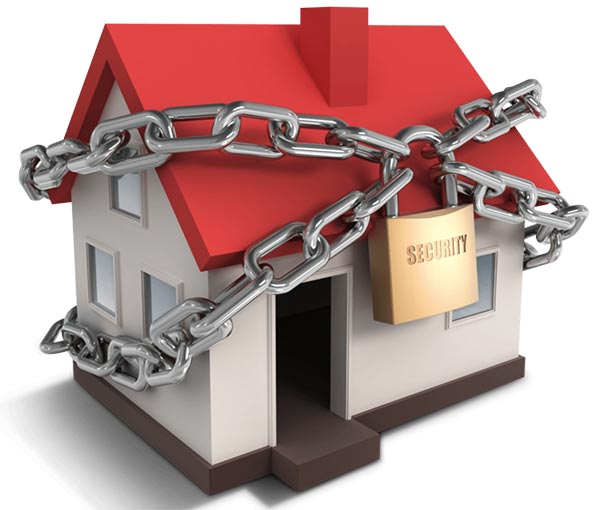
There’s no such thing as a totally secure home. If the prize is big enough, even minefields, electric fences and armed guards won’t deter criminal masterminds.
But that doesn’t mean you have to give up. Here are some of the steps most likely to help you secure your home:
Any combination of the above could encourage burglars to skip your home and move onto a more vulnerable one.

Chip Wade of HGTV and the DIYNetwork is known for such shows as “Designed to Sell,” “Curb Appeal” and “Elbow Room.” He’s also a Liberty Mutual Consultant – and a new survey from Liberty Mutual revealed that for 52% of consumers who completed a DIY project, saving money was the number one objective. With all this in mind, he offered some simple DIY ways to transform your backyard into an outdoor haven on a budget.
Some homeowners get carried away and want to create multiple backyard spaces, but Wade advises against this approach. “For most clients, I actually encourage them to look at smaller outdoor living setups that are close to the house structure, rather than making multiple destination areas.” He also believes that this will help you concentrate more of your budget in one place.
The first and most important step is to think about your main goal in creating your outdoor oasis; Wade says that planning ahead will make the final design more effective. “If you’re an entertainer and plan to host large parties, the layout might be different than if it’s just for the family to eat outside or watch the sunset once in a while.”
If this is your first DIY project, don’t bite off more than you can chew. Start simple. “Doing something as small as changing up the trellis could change the look of your deck drastically,” Wade says. “Or, you can use the trellis to hook on a swing and bring your seating up off the ground.” Off-ground seating facilitates easier cleanup and makes the space feel airy.
Wade recommends keeping it simple with plants as well. “Start with the hardscape, then work on creating very focused areas,” he says. “It forces the eye exactly where you want it.” He recommends creating a few landscape beds using focused colors. “Minimize maintenance, and make clearly defined paths from one feature location to the next.”
Regarding exterior light, Wade believes that an overhead structure is your best bet, but there have been advancements in low-voltage backyard options. “My recent projects have included LED lights — safe, bright and long-lasting. Put lawn lights around the focal features of the yard, for example, or light up a water feature.”
Because this is your outdoor haven, you also want to be comfortable even among the elements. “Consider adding a cooling feature to beat the heat,” Wade says. “If you have an irrigation system, you could add a perimeter misting wall around your hardscape patio.” And, since some of these systems spray a fine mist that reaches up to eight feet, this can also act as a barrier for mosquitos.
An easy project to transform your backyard is a hardscape patio. A hardscape patio provides immediate functionality, and you can avoid having a maintenance-intensive backyard. Or, as Wade says: “Less grass to mow, fewer flowers to maintain.”
However, if you’ve never done something like this before, he recommends that you do your research. While it’s definitely a project that homeowners can tackle themselves, using the right materials is crucial. A gravel patio, one of the easiest options, adds texture and interest to your backyard. There are several types of decorative gravel to choose from, including quartzite and pea pebbles, with colors from gold to gray to black to white. If you opt for flagstone instead, make sure it’s at least two inches thick so it won’t crack.
To avoid DIY fails, it’s a good idea to start collecting ideas and inspiration a year in advance. “You do not need that much time,” Wade says, “but a good design can take up to eight weeks to create, and it’s important to consider that to get a realistic time frame.”
It’s also crucial to check with your insurance company before you begin to transform your backyard, especially if you’re doing a major renovation. “If you’ve added a section to your home that increases its value, be sure to ask your rep if you need more insurance coverage to protect your investment.”
However, even with the best intentions, some projects may ultimately require a professional. The Liberty Mutual Insurance survey revealed that 32% of DIY homeowners experience a DIY fail. “Unless you are 100% confident you can safely complete the project, I recommend hiring a professional,” Wade says. “There are many maintenance tasks that I call DDIY: don’t do it yourself.”
He puts roofing in this category, saying, “Unless you are certified, you should never get on the roof.” Other important tasks that should be left to the pros: electrical or gas projects, toxic material removal and plumbing.
“Give yourself enough breathing room so the process does not feel rushed and you have enough time to think about how changes affect your entire project,” Wade advises. “In the warmer months, professionals often book out far in advance.”

Anyone who’s ever tried to manage a remodel can tell you that it’s a huge undertaking. Between trying to stay on time, on budget and on top of a thousand moving parts, it can feel like another full-time job. It’s far from impossible though. In fact, with a little prep work and organization, you can plan a home improvement project like a pro, even if you’ve never tackled one before.
If you’re just about ready to plan your next remodel, this post is for you. We outline the steps needed for every aspect of these projects. Keep reading to get the scoop on all the work that goes into planning a remodel — and how you can pull it off the right way.
First thing’s first: You can’t move forward on your remodel until you know what the final product will be. This is truly one situation where you need to work backward. Once you have an end point in mind, you can go about creating a step-by-step plan on how to get there.
Start by making a list of any must-have features. For example, you might want a kitchen remodel that includes an oversized island or a guest room/office combo. Then, use sites like Freshome to gather design inspiration. You know you’re ready to move on to the next step once you have a clear picture of what the completed project will look like. Jot down these details so you can refer to them later.
Next, it’s time to create a budget for the project. There are plenty of templates online you can use to keep the process organized, but your goal should be to go through each factor of your remodel, one at a time, and find a realistic estimate for it. Consider factors like getting permits, acquiring the necessary materials, expected labor costs and expenditures for aesthetic touches.
Odds are, if you’ve been dreaming about remodeling your home for a while, you probably have a figure in mind. Use these estimates to determine if that figure is realistic. If not, consider making some changes to your design plan or saving up for a little while longer.
The next step is to figure out who exactly is going to work on the remodel. If you’re planning on bringing in the pros, now is the time to get your quotes. Research qualified contractors and pick two or three to interview and ask for project estimates. From there, you can narrow down which company seems like it best suits your needs and bring it on board.
Even if you’re planning on the DIY route, if you’re working with multiple people, you want to go through each task — from laying flooring to painting walls — and delegate who is responsible. Nothing slows down a remodel more than confusion over who’s in charge.
By now, you should have a firm idea of all the steps required to bring your project to fruition. At this point, all you really need to do is put them in the order that makes the most sense. Once you have an ideal start date in mind, go to each of your team members, in turn, and ask for an estimate of how long the project should take. Then, lay out these time frames, accordingly.
If you’ve never planned a remodel before, don’t be afraid to rely on professional advice. Ask how remodels like yours have gone in the past and which order of tasks makes the most sense. For example, if you’re remodeling a bathroom, is it better to work on plumbing or lay tile first? You never know what you may learn in the process.
Let’s be honest, despite our best efforts, no remodel is ever going to go perfectly to plan. The best thing you can do for yourself — and your stress levels — is to assume a few setbacks will happen and plan for them. Be sure to pad both your budget and schedule for unforeseen expenditures and timing snafus.
Honestly, even though we know you’re probably invested in getting the project done as soon as possible, the more breathing room you leave, the better you will feel.
Preparing for a remodel is tricky. Sometimes it seems like there are too many moving parts to keep track of. That doesn’t mean it can’t be done. All it takes is a little forethought and organization. When you’re ready to plan your next remodel, keep these tips in mind. They’ll help you create a framework to bring your vision to life.
The post ‘How to Plan Your Next Remodel Like a Pro (Without Going Nuts in the Process)’ appeared first on Freshome.com.

Ok…I understand this is a bit outside the realm of Phoenix real estate and mortgage topics, but I found it fascinating nonetheless.
Amazon’s Alexa is fantastic at helping you create lists. Grocery lists, chore lists, honey-do lists, etc. Now Amazon is giving you the power to tally absolutely anything, and a lot of it.
The company is expanding Alexa’s shopping and to-do list functions to include custom lists. So, you’ll be able to compose lists for different stores, like Walmart and (if Amazon has its way) Whole Foods. Plus, you could make specific lists for your travels, family members, and even holidays. Once you’re done, your list will be saved to the Alexa mobile app — plus, you can now use Alexa skills to sync all your new lists with select third-party apps too (including Any.do, AnyList and Cozi).
The feature is currently rolling out and will be available to all Echo devices over the next few days.
If you’re in proud Alexa owner in Phoenix, I’d love to hear how you use yours. Give me a call at (602) 555-5555 or shoot me an email.
Like what you see? Make it Yours!